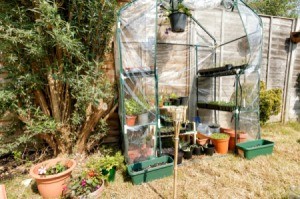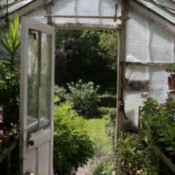
 Imagine how wonderful your garden plants would grow if you had total control over their temperature, light, and humidity and they never suffered damage from any garden pests. It may sound like a fantasy, but having your own greenhouse can give you that kind of control. Building a greenhouse doesn't have to be expensive. It depends on how simple or complex you want to make it. Here are a few tips to planning the ultimate do-it-yourself gardening project on a limited budget.
Imagine how wonderful your garden plants would grow if you had total control over their temperature, light, and humidity and they never suffered damage from any garden pests. It may sound like a fantasy, but having your own greenhouse can give you that kind of control. Building a greenhouse doesn't have to be expensive. It depends on how simple or complex you want to make it. Here are a few tips to planning the ultimate do-it-yourself gardening project on a limited budget.
If you plan on growing all of your vegetables year round, you're going to need a large greenhouse set-up that allows you to control the temperature, light and humidity. On the other hand, if you're just looking to extend your growing season by a few weeks, you can easily get by with a much less complicated system. Before planning your greenhouse, ask yourself what you want to grow in it and how much space you'll really need.
Permanent greenhouse structures are available in many sizes and shapes, ranging from lean-tos and window attachments to small, freestanding patio-sized units and units that can be mounted onto walls. During your planning phase, keep in mind that freestanding units will be the easiest to expand, but if you need utility and water hook-ups they'll be a lot more costly to install. Lean-tos are attached to already existing walls of buildings. This saves the cost of building one less wall and also gives you easier access to utilities. The downside of a lean-to greenhouse is that the existing wall can limit light and it will be more difficult to expand in the future.
The optimal site orientation for a greenhouse is on the south or southeast side of a building, tree or other large structure. An area where plants can get all day sun exposure is ideal, but if that isn't possible, an eastern exposure is a good second choice. Exposure to morning sun is the most important because if a plant's biological processes can get jump started early in the morning, it has the rest of the day to optimize growth.
To avoid the expense of installing a supplemental drainage system, plan to site your greenhouse on high ground. This will make is easy for water and irrigation systems to drain freely away from the site.
There are advantages and disadvantages to all types of greenhouse framing materials. Wood is easy to work with, but even when using rot-resistant wood like cedar, over time it will succumb to the elements and have to be replaced. Wood is not as good as metal at transferring heat, however, which is an advantage if you're planning a greenhouse without a mechanical heating system. Scrap or reclaimed lumber is also readily available. For the budget minded, plastic ribs or PVC make flexible, lightweight supports that are both durable and inexpensive. They work especially well for smaller, freestanding units.
Not only is a dirt floor inexpensive, but it's the best option environmentally. Use a high-quality soil that drains well to make a floor. By covering it with a layer of landscaping stone or gravel you will prevent things from getting muddy. When you need to raise the humidity, simply spray the floor down with water.
Gardener's have many options when it comes to glazing (coverings) for greenhouses. It's best to try and evaluate them by cost, durability and their ability to transmit light. Polyetheylene and other plastics make the least expensive glazing materials. Look for the newer, thicker plastic films though, or you'll be replacing them every year. The thicker films stand up better against the elements, but they will also eventually tear from wind damage or be degraded by the sun. Re-use centers often sell inexpensive windows from deconstruction projects. These can be easily fitted onto a wooden greenhouse frame and also be worked into the ventilation plan.
The amount of heat your greenhouse needs depends entirely on your climate and what you plan to grow in it. If sited properly, your greenhouse will act an effective solar collector and need very little, if any, additional heat. If your climate is very hot, you may want to consider building your greenhouse next to a tree or building to provide it with some afternoon shade.
To ward off the cold, cooler climates can use insulated panels or blankets during the coldest periods. Water can also be used to collect and store heat. Paint metal drums or troughs black to absorb maximum heat. By placing boards over the tops of them, you'll have instant heated shelving for your plants. Electric heating cables can also be laid across benches. These work well for keeping the soil in your pots warm, but won't add to the overall temperature inside the greenhouse.
Create a circulating flow of air by leaving openings for ventilation near the floor and creating an outlet for air near the peak in the roof.
Garden magazines are a good place to look for free plans, and there are hundreds of great links to free greenhouse plans on the web. Here are three:
You can also find some information on how to build a greenhouse here: www.bluegrassgardens.com/